Spices in Kitchen Basics Beef Broth Ingredients
A rich and flavorful homemade beef broth stock is one of the essential recipes every home cook should have in their array of kitchen cooking basics.
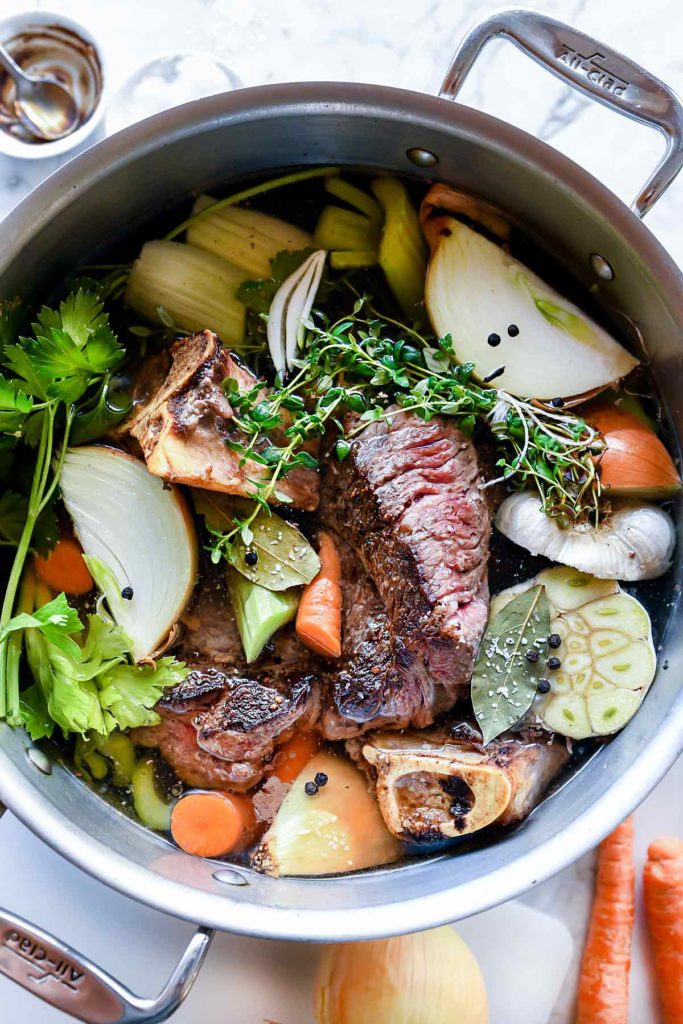
Back in the day there were recipes home cooks didn't even have to think twice about how to make because they made the same dishes so often no recipe was needed. Cooking was done by touch, intuition, and repetition.
Remember when you'd ask grandma how she knew when the pie dough had enough moisture or how she could tell the chicken was cooked through? The answer was annoyingly cryptic and didn't really help things when she replied, "You just know."
But now, with pre-made ingredients and an avalanche of recipe options at our fingertips, we can make just about any style of cuisine without batting an eye. But as a byproduct of creating these dazzling Pinterest friendly meals, making some of the good-old, most commonly used basics, like homemade broths and stocks, has fallen out of favor.
It's time to get back to the basics friends. Back to real good real food.
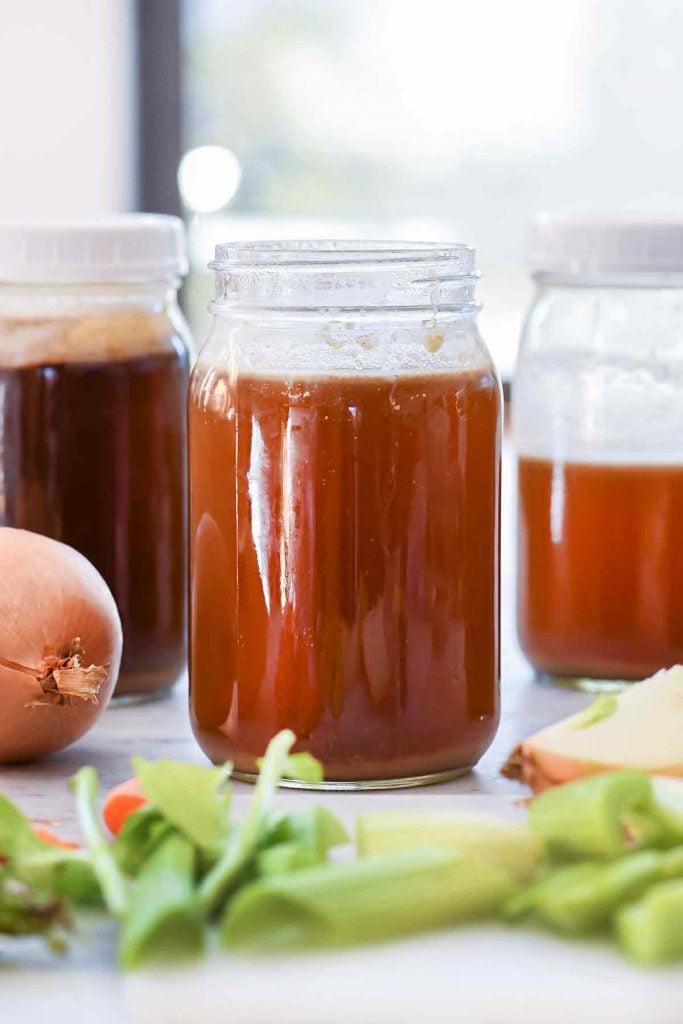
A few months ago I shared my recipe for the very best chicken stock because it seems that homemade broths and stocks are rarely on the must-make radar of today's home cook. The reasons vary from assuming it takes way too much time to make them from scratch to being unsure what ingredients go in the dang recipe (and fyi it isn't just the meat that matters, its the bones!)
That's why I'm waving my foodie recipe wand and pulling the beefy secrets out of my hat so that….TADAAAA!!!! Your bone stock broth cure is here.
This post breaks it all down, with simple steps and fool-proof instructions that'll put you on your way to making homemade beef stock with confidence. Let's go.
What's the Difference Between Beef Broth and Beef Stock?
While often interchangeable, there is a difference between broth and stock. Where you find it most is in the world of flavor.
Beef broth is usually the liquid meat is cooked in, sometimes with added vegetables. Broth is usually seasoned with herbs and spices, and sometimes a splash of wine or acid to balance the flavors to be drinkable on its own.
Beef stock is more meaty flavored than beef broth. It gets its richness from beef bones that have been stripped of their meat for common cuts of beef. As the bones cook in regular old water, they release gelatin (or collagen) that thickens the broth/stock and imparts beefy flavor.
One thing you'll want to watch is how much salt you add to either batch. I suggest keeping it on the lighter side and adding it at the end to taste.
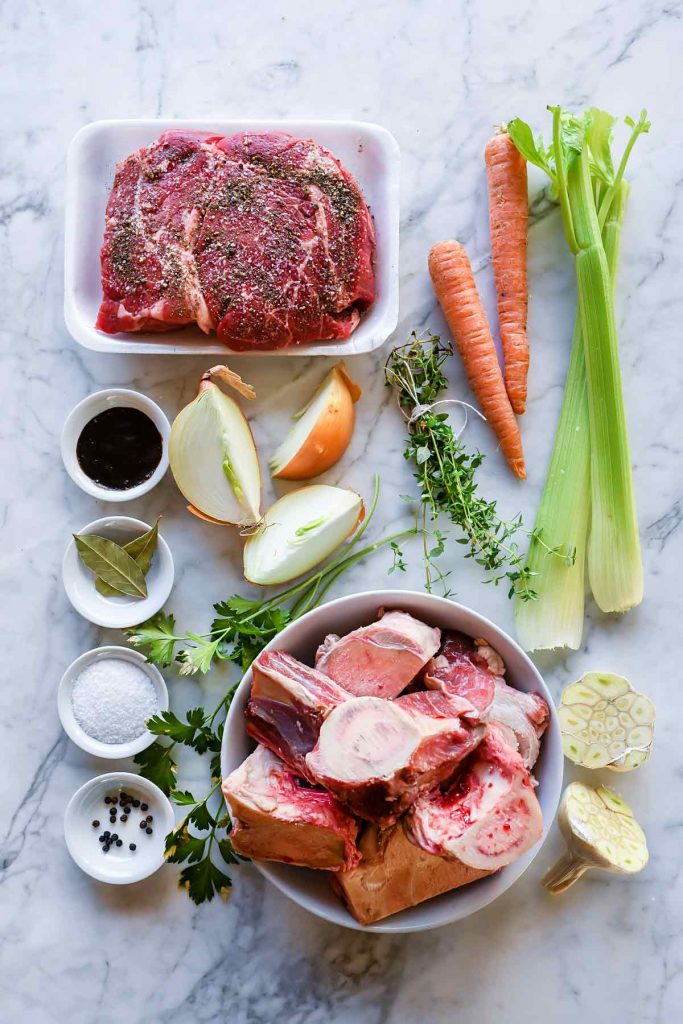
So Then…What Is Bone Broth?
Ever since the paleo diet became trendy, bone broth has become "a thing", and for good reason.
Bone broth is essentially the same thing as beef stock: bones in water that are simmered low and slow with vegetables. It's restorative, said to help with digestion, joint health and a myriad of other health benefits. It's also said to create radiant looking skin. No wonder everyone's trying it.
What Ingredients Do You Use to Make Beef Broth or Stock?
My beef stock bridges the definitions of beef broth and beef stock by using both a cut of beef and raw bones.
These are the main ingredients you'll need to get that beefy bite.
Cuts of beef to use for broth or stock:
- Chuck roast
- Beef shank
- Beef short ribs
- Belly or beef skirt *along with neck bones, this is what our cooking teacher in Vietnam used for the broth she uses for Pho
Types of bones to use for beef stock:
- Neck bones
- Shin bones
- Knuckle bones
- Oxtail
- Avoid using marrow bones all by themselves as they don't have any meat on them and have that round hole of fat in the middle that won't add any flavor, just fat.
Because these types of bones are more common in ethnic cooking, I buy them at the Asian or Mexican grocery stores.
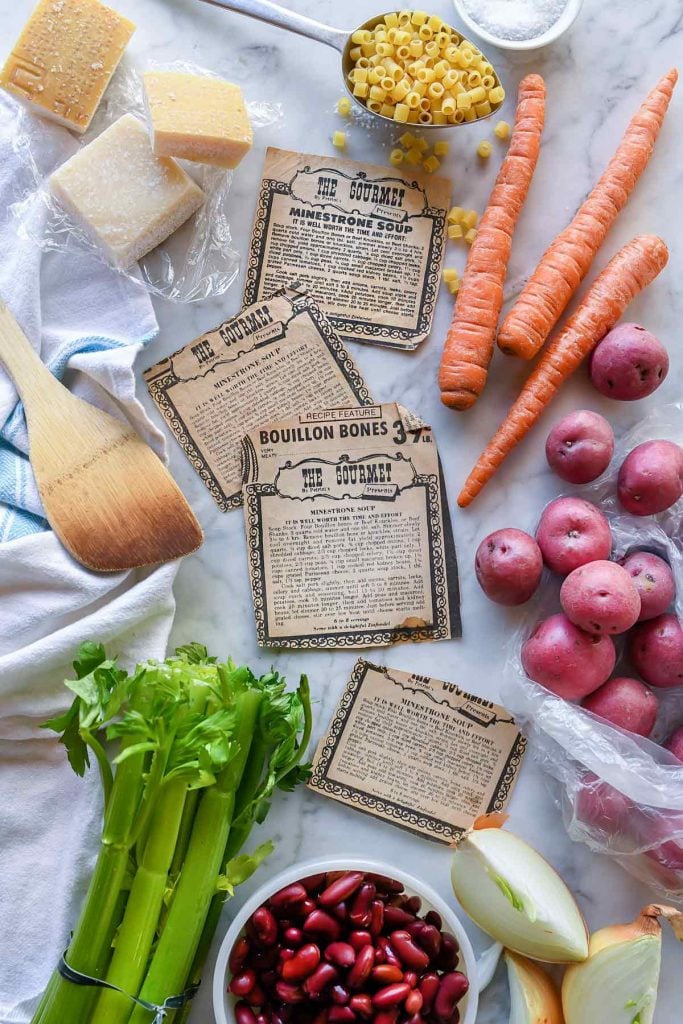
Types of vegetables & herbs I use for beef stock:
Some purists will sneer at the thought of adding vegetables to beef stock, but to me, it rounds it out, especially if you're using the stock for soups or pot roasts or chilis, where veggies will typically be added anyway.
- Carrots
- Celery
- Onions
- Parsnip or leeks
- A whole head of garlic cut in half
- Fresh thyme
- Fresh Italian flat leaf parsley
- Bay leaves
- Peppercorn
Tip: There's no need to peel the veggies, simply toss them all in the pot.
I also add beef base bouillon to the pot, just to give the stock a head start
How Long Do You Cook Beef Stock?
The longer you cook or simmer your stock and the gelatin breaks down, the richer it will become. The shortest amount of time I cook my stock is usually 2 hours. The longest has been 8 hours. Cooking time usually depends on how much time I have for keeping tabs on it.
To achieve a deep colored broth, consider roasting the bones and vegetables for 30 minutes before adding to the pot. I rarely add this step. Instead, I season and brown the cut of beef and the bones in my soup pot or dutch oven before adding water. Sometimes I'll brown the vegetables with the bones, and sometimes I don't. I suggest you play around with it until you find a flavor you prefer.

How Long Does Beef Stock Stay Good In the Fridge?
Homemade stock will stay good in the fridge for 5-7 days, although I've been known to let it go longer than that. Signs it's time to discard are when the stock gets cloudy or doesn't pass the smell test.
Don't be alarmed if you see a gelatinous layer of fat form on the top of your stock as it cools in the fridge. Gelatinous blob=more flavor, and more flavor is good. It's just collagen rendered from the beef bones, and it also helps preserve the stock while in the refrigerator. However, if you plan on freezing your stock, you'll want to scrape off the fat before doing so. Freeze the broth for up to 6 months.
Tips for Freezing Stock
- Make sure to leave an inch of space between the stock and the top of the container you're freezing it in, allowing enough room for the liquid to expand in the freezer.
- Freeze stock in freezer bags, in 4-cup portions, since that's the amount of stock many soup recipes call for. Fill the bag and lay flat on a shelf until frozen, then stack upright like little chicken stock soldiers.
- If you want to freeze smaller portions of stock for recipes that don't call for much, ice trays or 1-inch muffin tins are the perfect vessels, and each one is roughly equivalent to 1/4 cup.Tip: These reusable silicone liners will make this a snap.
- Always remember to label and date! And don't forget, homemade stock will stay good in the freezer for up to 6 months.

5 Recipes That'll Put Your Homemade Beef Stock to Work
- My Mom's Homemade Spaghetti and Meat Sauce
- Beef Stew with Butternut Squash (Instant Pot, Slow Cooker)
- Easy Hamburger Vegetable Soup
- Roasted Mushroom Beef Stroganoff
- Homemade Cheeseburger Macaroni
If you mak e this recipe, please let me know! Leave a ⭐️⭐️⭐️⭐️⭐️ rating on this recipe below and leave a comment, take a photo and tag me on Instagramwith #foodiecrusheats.

Easy Homemade Beef Broth Stock
Be sure to skim the foam and solids that rise to the top of the stock with a fine mesh strainer every 30 minutes or so. Doing so produces the best, clean, beefy flavor.
Calories 347 kcal
- 1 tablespoon canola oil
- 1 1/2 pound beef chuck roast or beef shank
- 5-6 pounds beef neck bones bouillon or soup bones
- Kosher salt and freshly ground black pepper
- 1 onion quartered
- 2 carrots cut into 4-5 sections
- 1 celery cut into 4-5 sections
- 1 parsnip cut into 4-5 sections (optional)
- 1 head of garlic sliced in half
- 2 bay leaves
- Bunch of thyme leaves
- Small bunch of parsley
- 1 tablespoon beef bouillon base
- 6-8 whole peppercorns
- 1/2 tablespoon kosher salt plus more after cooking to taste
-
Warm the oil in a dutch oven or large stock pot over medium high heat. Season the chuck roast with kosher salt and freshly ground black pepper and brown in the pot on all sides then transfer to a plate or platter. Add the bones and brown in batches on all sides. Add the chuck roast to the pot with the browned bones, carrot, celery, onion, garlic halves and parsnip (if using. Add 4 quarts cold water, covering the beef and veggies by at least 1-2 inches. Add a handful of the parsley (with leaves and stems intact), thyme sprigs, peppercorns, bay leaves, beef bouillon and kosher salt.
-
Bring to a boil, then reduce to a simmer and skim the stock with a fine mesh strainer every 30 minutes or so. Cook partly covered for 2 hours up to 8 hours or until the stock is rich and brown and tastes well flavored. Add more salt to taste if necessary.
-
Turn off the heat and allow the broth to cool or if using immediately, place a large colander over a Pyrex 4 cup glass measuring cup and slowly drain the broth from the rest of the aromatics so the colander catches any veggies or bones that may fall from the pot. Then, use a fine-mesh strainer to strain the stock into your next recipe's soup stock pot. Or, if storing to use later, strain into 1 quart wide-mouth glass canning jars and cool before adding a tight fitting lid. Refrigerate for up to 5 days or freeze in gallon bags for up to 6 months.
Calories: 347 kcal | Carbohydrates: 53 g | Protein: 5 g | Fat: 15 g | Saturated Fat: 1 g | Sodium: 3625 mg | Potassium: 1236 mg | Fiber: 14 g | Sugar: 19 g | Vitamin A: 20561 IU | Vitamin C: 44 mg | Calcium: 137 mg | Iron: 2 mg
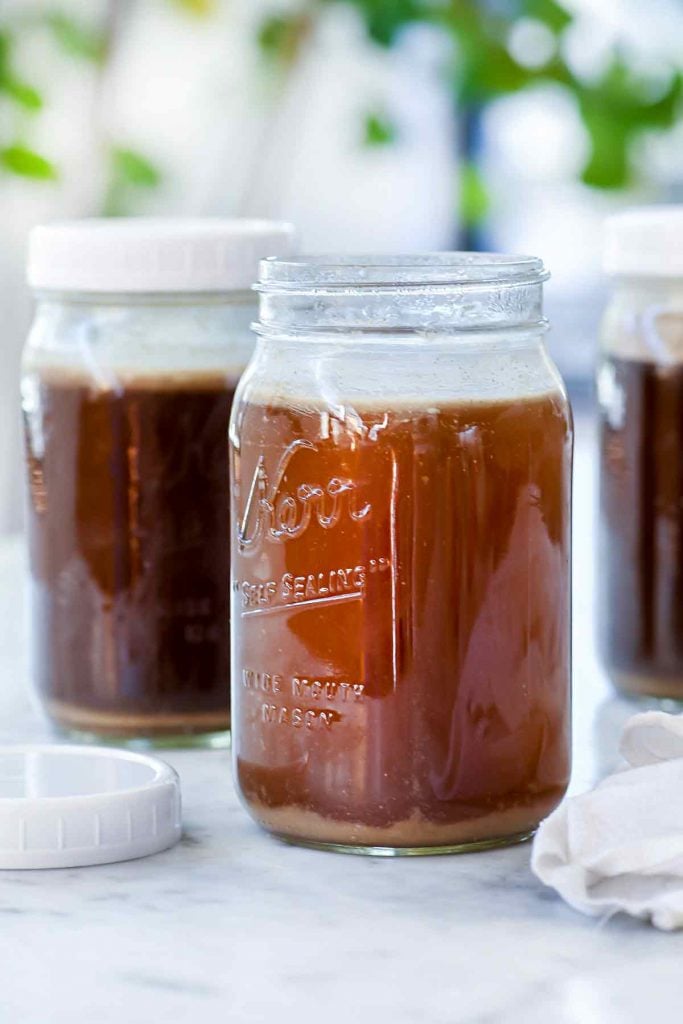
We send good emails. Subscribe to FoodieCrush and have each post plus exclusive content only for our subscribers delivered straight to your e-mail box.
Follow me on Instagram , Facebook,Pinterest and Twitter for more FoodieCrush inspiration.
As always, thank you for reading and supporting companies I partner with, which allows me to create more unique content and recipes for you. There may be affiliate links in this post of which I receive a small commission. All opinions are always my own.
Source: https://www.foodiecrush.com/easy-homemade-beef-broth-stock/
0 Response to "Spices in Kitchen Basics Beef Broth Ingredients"
Post a Comment